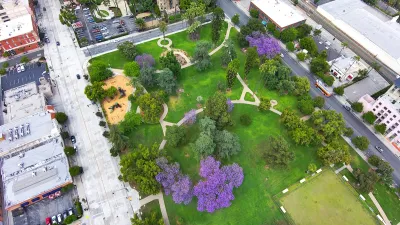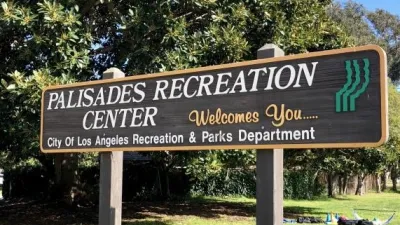Like the rare Corpse flower that blooms every several years, the Los Angeles chapter of the American Institute of Architects is planning to publish yet a new magazine exploring and extolling local design, how it impacts “our everyday life,” and “who architects are as people.” Such an effort at such a time deserves notice.
Like the rare Corpse flower that blooms every several years, the Los Angeles chapter of the American Institute of Architects is planning to publish yet a new magazine exploring and extolling local design, how it impacts "our everyday life," and "who architects are as people." Such an effort at such a time deserves notice.
The vainglorious offering will be the latest in a string of efforts by the city's design community to promote the local scene, which in the past, like the Corpse, can be stunning to view, but also emit a smell that can be off putting, no thanks to pernicious personalities and academic infighting. The timing in today's faltering economy and fading print media landscape, provide other challenges .
Still, the venture should be applauded, especially if, like me, you were nurtured on print, believe that planning and design are critical to the hope of a livable world, and yearn for more outlets for discussion and debate. And that includes comment by even the most vain practitioners and their stooges in a supercilious, celebrity driven L.A. where architecture and planning competes for ink in the shadows of the city's dominant entertainment industry and blustering politics. It is a rough arena for design publicists.
For a choral article in the initial "coffee table" issue of "LArchitecture" planned for September, several critics and commentators were posed a list of questions focused on Los Angeles, but relevant to any urban construct, and deserve reflection. And since I am not being compensated by the new publication, presumably trading my labors for notoriety, I feel free sharing a personal preview.
The first question: what did I think about the city's transformation from a "beloved" low density, single family city" to "high-density, multi-family living." Clichés are best answered by clichés. Being a born and ill-bred New Yorker, I most likely would not have loved the incipient suburban sprawl that once dominated L.A.
It is obvious that if cities are to survive they must change, and indeed L.A. is doing that, more slowly than planners and the ever needy, greedy development community may want, but quicker than the citizenry and its ever present nimbys prefer. I find the transformation challenging.
To be sure, L.A. will always have attractive residential enclaves, architectural and cultural landmarks, and sensitive environments that need to be preserved. But there is, and will continue to be, increased pressure to respond to the need for more density to accommodate growth. And growth will occur, whether we like or not. The challenge is how to shape it. As always in design and development, the devil is in the details. Last year's ULI winners won't cut it. A more imaginative eclectic mix might.
Personally, I like density. But over the years I have come to accept the fact that L.A. is not my New York past or present, nor should the editors of "LArchitecture" think it ever will be. With its benign climate, mix of cultures, and collage of contexts, L.A. demands an architecture that should not be a self conscious response to the clichéd prejudices of the eastern and euro design establishment forever passing judgment on L.A., or their western mimics desperate, if not for tenure, than for a visiting critics post.
The editors also wanted a dash of hindsight; to look back at the urban development of the city, what has been a missed opportunity or a mishandling of a design opportunity and what can we learn from it? That would fill a book that unfortunately I don't think anyone would read. The sad fact is that LA. has turned its back on the what should have been a defining river, sealed off sections of a beckoning beach by select development and poor public transit, and most of all isolated each other by neglecting public spaces and places. So many opportunities, so little imagination. But thankfully not irreversible.
And talk about provocative questions, the editors also want to know whether the city needs more iconic buildings. Of course it does, but iconic as in distinctive, places for human endeavor, not as studied pieces of fragmented sculpture. Plop architecture for a pop environment. Indeed, L.A. is a city where every style has had its moment in the sun, and a parade of architects their 15 minutes of fame validated by a chorus of counterfeit critics. While the city's tolerance for follies and fantasies can be appreciated, there have been embarrassments of self-and-publicity–conscious conceits.
Finally the editors ask, "What city could LA inspire to become – is there another city in the world that could offer a model that could adapt to LA and improve the city? " Hopefully I have made it clear that to fulfill its promise a city must respond to its unique culture, climate and context. But indeed if there is a city that perhaps can serve as paradigm to L.A., offering a glimpse of the future now, let us know. It could be a travel column for the new magazine.

Alabama: Trump Terminates Settlements for Black Communities Harmed By Raw Sewage
Trump deemed the landmark civil rights agreement “illegal DEI and environmental justice policy.”

Planetizen Federal Action Tracker
A weekly monitor of how Trump’s orders and actions are impacting planners and planning in America.

The 120 Year Old Tiny Home Villages That Sheltered San Francisco’s Earthquake Refugees
More than a century ago, San Francisco mobilized to house thousands of residents displaced by the 1906 earthquake. Could their strategy offer a model for the present?

Ken Jennings Launches Transit Web Series
The Jeopardy champ wants you to ride public transit.

BLM To Rescind Public Lands Rule
The change will downgrade conservation, once again putting federal land at risk for mining and other extractive uses.

Indy Neighborhood Group Builds Temporary Multi-Use Path
Community members, aided in part by funding from the city, repurposed a vehicle lane to create a protected bike and pedestrian path for the summer season.
Urban Design for Planners 1: Software Tools
This six-course series explores essential urban design concepts using open source software and equips planners with the tools they need to participate fully in the urban design process.
Planning for Universal Design
Learn the tools for implementing Universal Design in planning regulations.
Clanton & Associates, Inc.
Jessamine County Fiscal Court
Institute for Housing and Urban Development Studies (IHS)
City of Grandview
Harvard GSD Executive Education
Toledo-Lucas County Plan Commissions
Salt Lake City
NYU Wagner Graduate School of Public Service





























